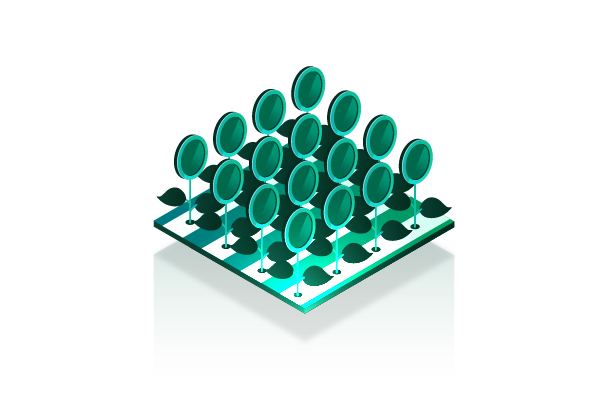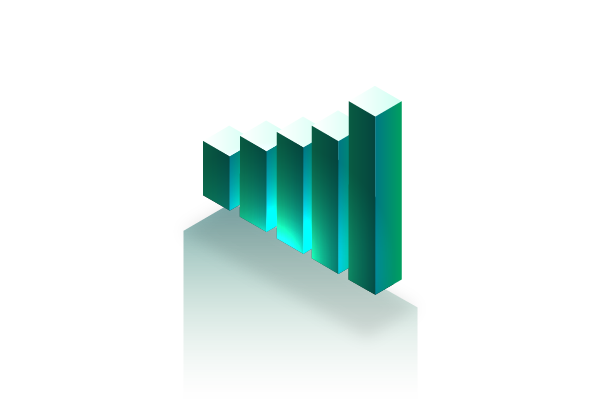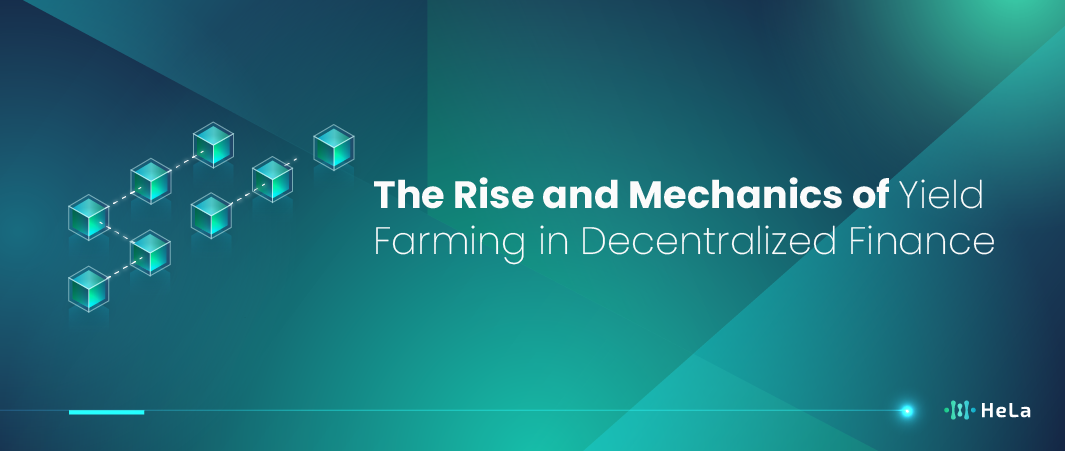Yield farming will remain a promising and highly profitable segment of the Decentralized Finance in 2025. Several platforms will remain outstanding because of their innovation, security, and opportunities for users. Taking the reins in this field is Aave, a lending and borrowing platform that has gained much traction for its deep well of liquidity and other advancements like flash loans and rate swap. With its focus on security and continuous developments, Aave has established itself as a go to platform for DeFi users looking for reliable high-yield investment opportunities.
Compound is another well-known project, which has a clear and very effective mechanism to lend and borrow crypto assets. Thanks to the high interest rates and convenient interface, Compound has been able to sustain a significant user number with high demand, guaranteed yield for farming.
Yearn Finance has introduced a new concept of yearned-based automated yield farming, helping users generate the most from their investments. Yearn Finance essentially provides an aggregated pool of funds and self-organizing mechanism for moving capital from one lending protocol to another in search of the highest yields, which makes the farming process in it easy and highly efficient, which in turn makes this project popular among DeFi fans seeking passive income.
What is Yield Farming?

Yield farming, also known as liquidity mining, is a popular approach in the DeFi industry where participants deposit or stake their tokens as a form of investment to earn profits or incentives. Instead, it relies on liquidity, which DeFi platforms require enormous amounts of assets to finance multiple operations ranging from lending, borrowing, and trading. The providers of these funds get a yield in return for supplying their assets to these liquidity pools with extra cryptocurrency tokens, transaction fees, or interest.
The process starts with users storing their crypto tokens in a smart contract, and the contract allocates the tokens to a pool of liquidity. These pools are useful for decentralized exchanges (DEXs) and other DeFi platforms to run efficiently. In exchange for this, users are issued liquidity provider (LP) tokens which give the user a stake in the pool. LP tokens can often be staked in other protocols to amplify earnings, which results in a relatively nested structure of possible gains.
Yield farming is potentially very rewarding, especially for relatively new DeFi projects since early staking rewards are typically higher in order to attract more liquidity providers. But, these high yields attract high risks associated with them. Fluctuations in the market can significantly impact the value of the assets in the pool and therefore result in losses.
Additionally, since smart contracts store funds, their bugs or exploits can lead to a security issue whereby users lose their money. One is that of impermanent loss that arises whenever the prices of staked assets fluctuate against each other and the value in the pool is less than holding the assets outside the pool.
Benefits of Yield Farming
Yield farming is one of the most popular and well-known practices within the DeFi ecosystem, which has many significant advantages for its participants. First of all, one of the major benefits is the possible high revenue on investment, which can be higher than in conventional financial instruments, such as deposits or bonds.
Lending and decentralized exchanges or lending platforms involve users earning interest, rewards, or extra tokens within DeFi protocols. It creates passive income so the users can optimize the return on investment by reinvesting the rewards they get and the profits are then compounded.
Also Read: 10 Best Cryptocurrency YouTube Channels to Watch in 2025
Besides, yield farming is important for improving the liquidity and the sustainability of DeFi environments. Forcing users to commit their tokens into liquidity pools guarantees that decentralized systems have sufficient funds to enable efficient trading and lending activities. That enhanced liquidity helps minimize slippage and increases the effectiveness of the DeFi market for more potential users.
Last but not the least, obtaining financial resources is made more democratic. Yield farming makes it possible to have access to financial services provided one has an internet connection eradicating barriers such as geographical location, class or access to banking facilities. This inclusiveness ensures the people in the less developed areas have a chance to access the global economy market thus providing them with an opportunity for economic advancement.
Top 10 Yield Farming Platforms to Know in 2025

Yield farming is typical for DeFi platforms, which allows users to receive profits from offering their tokens to multiple projects. It involves warehousing cryptocurrencies and offering traders or borrowers trading or borrowing capabilities on decentralized exchange or lending platforms. The concept of risk in yield farming is in the prospects that DeFi platforms have for volatility in a way that the high yields entice investors. Yield farmers must consider factors such as the popularity and reliability of the platforms, the tokens available, the withdrawal conditions of each platform, and potential risks related to this type of activity. Here are ten of the best platforms for crypto yield farming in 2025:
1. StableHodl
StableHodl is a new-generation yield farming service designed for investing in stablecoins, which is powered by the HeLa Network, thus guaranteeing optimal and stable profits. It also uses funding arbitrage across multiple cryptocurrency exchanges, ensuring high profitability for its users. Holding HLUSD has other advantages including stable and liquid rewards where, for instance, staking stable coins such as USDT and USDC yields HLUSD. It does this by reducing fluctuations commonly experienced with other crypto assets, thus making it more secure to invest.
The distinctive characteristics of StableHold include a simple interface and the absence of a minimum staking amount, which attracts both beginners and professionals. APY is relatively high, during the testing phases, it ranges from 26% to 49%. Moreover, it has the “Boosted Points”system that encourages users and is linked with the rest of the HeLa ecosystem, so rewarding the user experience is enriched.
2. Yearn.Finance (YFI)
Yearn Finance is one of the decentralized finance applications with a focus on yield farming and is based on the Ethereum network. Created by developer Andre Cronje in February 2020, Yearn Finance has become one of the major DeFi players as it provides an effective and less confusing way of yield farming. Yield farming refers to the process of swapping assets and money in different DeFi platforms to attain the maximum yield possible for a certain investment which may be challenging for common users due to the volatile environment and high gas fees.
Yearn Finance has its solutions, which include Vaults, Earn, Zap, and Cover, to overcome these challenges. Of which, the most recognizable vaults enable users to staking their assets into strategy-based pooled investments that autopilot across various DeFi services to achieve maximum returns within the least amount of risk and trading fees charged. These are constantly evolving and are controlled by community developers who suggest new ones and changes, which are then passed through an off-site vote which involves YFI token owners.
Also Read: 7 Top Crypto News Websites to Visit in 2024
3. Aave (AAVE)
Aave is one of the first DeFi solutions that disrupts the centralized financial markets, allowing users to lend and borrow multiple decentralized cryptocurrencies without involving third parties such as banks. Created by Stani Kulechov and previously known as ETHLend until 2020, Aave first emerged as a decentralized lending and borrowing marketplace in 2017. Aave defined as “ghost” in Finnish, the name captures the spirit of the platform helping and facilitating DeFi processes but remaining unnoticed.
Thus, utilizing high levels of security and constantly evolving, Aave has grown to be one of the most prominent protocols in the DeFi space. Due to the simplicity of the interface and having on offer almost all services that can be found in other platforms, Aave is quite popular, both among beginners and advanced crypto users. Through the utilization of blockchain, Aave increases the status of people’s financial accessibility and enables users around the world to participate in financial activities which were unattainable or barely achievable using traditional methods.
4. UniSwap (UNI)
Uniswap is one of the first decentralized exchanges (DEXs) developed through the Ethereum blockchain and has become an important element in the overall DeFi ecosystem, especially when it comes to yield farming. Yield farming is a relatively new practice in the field of decentralized financing, where instead of holding coins, users can lend them and get passive income in return. Uniswap enables this process through the use of its AMM framework, which eliminates the use of standard order books to facilitate token exchanges on the Ethereum network.
Uniswap empowers users to come in as liquidity providers by staking pairs of tokens in liquidity pools that are the basis of the platform’s trading architecture. Liquidity providers receive LP tokens of their share in the pool and a cut of trading fees from transactions inside the pool. This mechanism not only encourages users to provide liquidity by providing incentives but also guarantees the efficiency of the exchange by providing enough liquidity for trading pairs.
5. Compound (COMP)
Compound is one of the most popular DeFi protocols due to its usage in yield farming which is a method of making profits through supplying liquidity to DeFi platforms. Founded in 2018, Compound is a protocol that provides lending and borrowing services for different types of cryptocurrencies. It allows users to deposit their tokens, including ETH, DAI, or USDC, into Compound liquidity pools. Consequently, they receive interest from their deposits, which is charged on the same asset that they provided.
Interest rates in the compound are automatically adjusted instantly depending on the supply and demand found in the protocol. This means that the rate at which the asset is borrowed is directly proportional to the interest rate for borrowing the asset and inversely proportional to the rate at which the asset is supplied and the interest rate for supplying the asset. This makes the platform flexible and automated, thus maintaining a balance between the lenders and borrowers of the funds.
6. PancakeSwap (CAKE)
PancakeSwap is a decentralized exchange that is built on Binance Smart Chain, which is a blockchain that is established by Binance, a leading cryptocurrency exchange platform. Introduced in September 2020, PancakeSwap has a strong demand due to lower fees and faster transactions compared to Ethereum-based DEXs. It employs an AMM mechanism through which clients can buy and sell the tokens without the assistance of a third party.
This platform has a simple and intuitive interface, and it provides such options as liquidity pools, farming, staking, and others – decentralized finance (DeFi). It is possible to receive revenue by adding liquidity to trading pairs or staking tokens for different pools. The token that represents PancakeSwap is CAKE. It has several functions in the platform like governance, fee reductions, and rewards payouts. Other ways through which users can also acquire CAKE tokens include the provision of liquidity mining and other various incentive schemes.
7. Curve (CRV)
Yield farming has become one of the trending activities within decentralized finance (DeFi) where users can participate in earning rewards by supplying stablecoins to the pools on the Curve Finance platform. Focusing on stablecoins, Curve Finance is a decentralized exchange that provides small slippage and high efficiency for the swap transactions with stablecoins created with references to fiat, like USD, EUR, or JPY. Yield farming on Curve thus involves staking stablecoins in the liquidity pools for use in trading as well as earning fees. As compensation for providing liquidity, users receive some of these fees, in proportion to their contribution to the pool.
Of the methods encouraged by Curve, yield farming is among the most popular because it offers extra rewards beyond trading fees. These rewards can be in the form of the native token for Curve, known as the CRV token, which has governance rights. CRV tokens are not only representative votes in Protocol upgrades and decisions but a stake in the Protocol’s revenue through control of fees administered through governance. Consequently, participating in Curve yield farming can provide users with a dual income stream, it is funded by two primary sources; trading fees and CRV token incentives.
8. Coinbase
Coinbase, founded in 2012 by Brian Armstrong and Fred Ehrsam, is one of the key market participants now. The following is one the most popular San Francisco-based exchanges since it provides a user-friendly platform for both new and experienced traders. People can conveniently trade with various coins such as BTC, ETH, LTC, and many others and securely store their assets. It is easy to use and it also has strong security mechanisms, which make its users consider Coinbase and secure digital currency exchange. Also, the platform has useful tools to help the users with trading such as live-price streaming, automatic purchases, and secure storage of digital assets. In addition to its consumer services, Coinbase offers highly functional trading services under the Coinbase Pro tray, fulfilling the needs of institutional traders and professionals.
Additionally, Coinbase now offers services such as staking, DeFi integration, and not only has increased the number of supported cryptocurrencies but also is clearly focused on further development which puts it in a position of leaders in the crypto industry. As a company with millions of customers from across the world and a focus on compliance with existing legislation, Coinbase remains one of the key actors promoting decentralized digital currencies to the masses.
9. Rehold
Yield farming, which is at the center of Re Hold’s ecosystem, relates to staking crypto assets to receive revenues in projects within the decentralized finance field. These can be transaction fees or other charges or even a fraction of the value of coins or tokens in a blockchain or other incentives that might be presented by the protocol. S
ome of the benefits of yield farming through Re Hold include; Increased yield; There is an opportunity to earn more yield compared to, for instance, saving by depositing money in a bank. That said, it is important to respect the fact that with the higher returns there comes a certain risk as well.
10. Havest Finance (FARM)
Harvest Finance is one of the leading decentralized finance (DeFi) platforms in the market that started in the year 2020. Harvest Finance is an Ethereum based project set for facilitating yield farming through the automatic rebalancing of users’ funds across available liquidity pools and farming opportunities. This automation helps the users to get the most of the deposited assets without having to spend much time or effort to monitor or adjust the accounts.
In simpler terms, Harvest Finance works by identifying various DeFi protocols and opportunities and then using yield farming methods to generate the highest returns possible. These strategies can include offering collateral to decentralized exchanges, lending platforms, or other DeFi platforms in exchange for additional tokens or interest payment. By constantly shifting the investments between these strategies depending on current trends and mathematical models, Harvest Finance aims to generate the highest ROI for consumers. Harvest Finance is easy to navigate for both a beginner and an advanced DeFi user since one just needs to deposit assets to Harvest’s vaults and start earning yields. For this, the platform offers various options for the selection of the vault, which has its own approach and level of risk and can be chosen according to the user’s wishes.
The Future of Yield Farming

Yield farming is a main major of DeFi and its future is set for a massive shift in the near-term based on these improvements in infrastructure and growing mainstreaming. In the current age of rapidly emerging and developing DeFi platforms, the use of yield farming has prompted more complex and innovative approaches that allow the implementation of more precise algorithms and artificial intelligence tools to achieve the best possible predictable results and control over potential risks.
These advances in technology will help create more variation and accuracy in the yield farming process and help the farmers respond better to the conditions of the market and earn the maximum amount of profit. Also, one could consider a broader adoption of yield farming as the integration of real-world assets into DeFi ecosystems may expand investors opportunities and diversify their risks. These could include tokenized real estate, commodities and other forms of real assets, which will make the DeFi space offer a more diverse set of yield bearing instruments hence improve on the yield aspect.
Yield farming is expected to flow deeper towards regulatory lenses as more investors get drawn into the new realm of finance in response, these yield farms are expected to work on improving their trail tracing, security propositions, and overall compliance. It could, therefore, potentially result in a more controlled DeFi ecosystem that is equally more stable, thereby encouraging institutional investors to invest in DeFi more for they have been hesitant to do so for one reason or the other due to the perceived risk factors associated with DeFi or such similar systems. Strengthened rules will also safeguard the interest of the retail investors, therefore leading to an improved and self-reliant financial market.
However, as Layer-2 solutions and cross-chain communication evolve, yield farming will regain its footing and will grow more effective. Below layer one technologies, roll ups and side chains are enabling constant transaction outputs to be processed at cheaper costs as a solution to scalability problems that have affected many DeFi platforms.
This would cause cross-chain asset transfers the fluidity of a primary market to move assets from one blockchain to another or to participate in yield farming across multiple platforms without having to get caught in the middle of several bridging processes. The user experience is the other area that is poised for growth, as more interfaces and educational materials become available to make the entry into the market easier for new entrants. With the development of non-professional interfaces on DeFi websites and an increase in educational projects, more people will be able to engage in yield farming, thus aiming at the decentralization of the financial industry.
How to Choose The Best Yield Farming Platform
Selecting the best yield farming platform involves a holistic decision-making process that requires a complex analysis to maximize profit and avoid failure. Firstly, the platform’s reputation and the availability of sufficient protective measures should remain the focus. Choose the options that can be trusted for their stability and safety, as well as use dependable encryption measures protecting your funds from possible intrusion or other malicious activities. Expand your research, explore the comments from the community, and check the platform’s strengths based on the analysis of such elements as smart contract audits, insurance, and multi signature wallets to protect your funds.
Additionally, evaluate liquidity pools that are hosted on the platform and tokens that are supported by the platform for investment. Make sure to seek out platforms that support various kinds of tokens and different assets to ensure that your tokens are not all in one basket. Also, assess the returns and yields that those pools can provide, as for annual percentage yield, token issuance, and rewards’ allocation schedules. Instead, target the platforms offering higher rates with stable farming stimuli to stay away from get rich quick schemes that may turn into a trap with time.
Also, assess the platform for fees, interface and overall utilization and farming experience in order to have a productive services experience. It is also important to specifically observe any costs such as deposit and withdrawal fees, transaction fees, or any other costs that are incurred when participating in farming activities. Also, consider the organization of the website and its overall appearance for ease of navigation, design, and usability for improving the customers flow and response to your products. Furthermore, it is necessary to check the community participation and developers, and the platform’s governance structure, as active and engaged communities and a well-developed governance structure might improve the platform’s stability and sustainability.
Conclusion
The analysis of DeFi platforms that provide liquidity points to the following key players: Uniswap and Curve Finance. A key proposition of Uniswap is based on the decentralized exchange model with the help of which users and investors can create and make Markets using Automated Market Maker, besides earning fees for putting and maintaining liquidity for various token pairs. It is easy to use, reaches out to many with its compatibility of different tokens.
As a platform that specializes in stablecoin swaps, Curve Finance ensures that trades are both highly efficient and have low slippage, thus allowing liquidity providers to get the best yield on their investments as much as possible while keeping the amount of risk as low as possible. The emphasis on stability and efficiency has made Curve an ideal place for farming yields with stablecoins on the spot.
Altogether, these platforms paint a picture of a highly fluid and evolving space that is still in the very early days of its development. Not only do they offer strong security and intuitive designs but they also advance with various aspects such as the ability to offer competitive profit and adding new features. With yield farming having brought in more and more participants to the space, these are the leading platforms to persist as leaders of DeFi into the future, as they continue to ensure optimal user gains and new innovations of the decentralized finance arena.
Disclaimer: The information provided by HeLa Labs in this article is intended for general informational purposes and does not reflect the company’s opinion. It is not intended as investment advice or a recommendation. Readers are strongly advised to conduct their own thorough research and consult with a qualified financial advisor before making any financial decisions.

